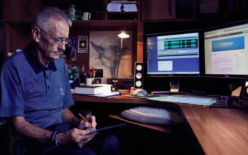Background
Prior to 9/11, handling hijack situations was a deliberative process under the assumption that the end result would be the landing of the hijacked aircraft at a negotiated location. FAA scope level procedures were also deliberative for both hijack situations and aircraft experiencing electrical and mechanical problems. American Airlines flight 11 was in the latter category until Mohammed Atta announced his presence in the cockpit over the air.
The exchanges between an air traffic controller at Boston Center and the cockpit of American Airlines flight 269 (AA 269) provide specific real-time information on how the hijack situation was handled. Here is that story as recorded at the Departure Flow Management Position, Traffic Management Unit, Boston Center (ZBW). (NARA Batch 5, tape 148-911-03007988L1.s1 for the period 1200-1245Z) The traffic management position was monitoring the channel of the controller for AA 269.
Controller-Cockpit Communications
AA 269 was handed off from Boston TRACON to Boston Center at 8:18 EDT climbing out of flight level 190 for 230. The flight was cleared to proceed to flight level 350.
0818 AA 269 Checks in with ZBW
Previously, shortly before 8:14, AA 11 turned 20 degrees right at controller direction and was then told to climb and maintain flight level 350. There was no response to that second controller direction. AA11 was over northwestern Massachusetts when AA 269 checked in with Boston Center.
Concurrently, the controller for AA 11 had begun a series of deliberate steps to regain contact with AA 11 by contacting Boston TRACON to see if AA 11 had inadvertently reverted to a previous frequency, a not unusual happenstance.
Then, at 8:21, AA 269 became part of the Boston Center attempt to gain contact with AA 11. The AA 269 controller advised that AA 11 was “nordo” (no radio), 80 miles to the west, and asked AA 269 to contact “company” (American Airlines) to assist.
0821 AA 269 Contact Company AA 11 Nordo
At the time, Boston Center had no indication that the situation with AA 11 was anything other than a technical problem. The AA 269 controller routinely asked the crew what their projected mach speed would be (.80) and AA 269 volunteered to try to reach AA 11 “on this frequency.” The crew was told that was not necessary since AA 11 had never been on the frequency.
At that same time the transponder aboard AA11 was turned off and the plane became a primary only, a search only, target. The last reinforced (radar and transponder) return from AA 11 was at 8:20:51, as recorded by the Riverhead radar supporting the Northeast Air Defense Sector. (84th RADES radar files)
0822 AA 269 Tried to Assist Further
Boston Center was trying everything, to include using planes in the air. Boston had ample evidence of a serious electrical or mechanical problem but no evidence that AA 11 was hijacked. The state of thinking at Boston Center was communicated to the crew of AA 269. Shortly after 8:23, the AA 269 controller advised the cockpit that “there may be some kind of electrical problem with your company flight.” AA 269 was also advised that Boston Center had “lost the transponder.” Boston Center also advised that AA 11 was “overhead Albany VOR.”
0823 AA 11 transponder lost and over Albany VOR
The estimate that AA 11 “had some kind of electrical problem” changed dramatically shortly before 8:25 when the microphone in the AA 11 cockpit was keyed at least twice followed by two pronouncements by Mohammed Atta in short order.
Summation to this point
Commission Staff concluded, “8:14 Last routine radio communication; likely takeover,” (p. 32, Commission Report). For nearly ten minutes Boston Center struggled with the problem of trying to gain contact with a commercial flight gone astray, with no success. This is a good example of the amount of time it takes in real time to identify, assess, and deal with unexpected circumstances. What was not known was that a member of the cabin crew aboard AA 11 had reported shortly before 8:20 to American Airlines that “I think we’re getting hijacked.” (Commisison Report, p. 5) Absent that information, Boston Center first knew the seriousness of the problem when Atta came on the air at 8:25.
Controller activity continues
At 8:27, the controller for AA 269 vectored a Northwest flight to avoid “nordo traffic.” At least one controller or traffic manager thought that AA 11 might be landing Albany and advised that the airspace needed to be cleared.
0827 Might Land Albany Clear Airspace
It was at that time that Boston Center made the first call to Herndon Center to advise about AA 11 and to request a patch to notify New York and Cleveland Centers of a potential problem aircraft entering their airspace.
The AA 269 controller then advised its crew to “make future attempts to contact company.” The crew asked if Boston Center had got a hold of him (AA 11) and was told “can’t talk about it.”
Comment
This short, focused article provides researchers, historians and academicians a different perspective on the hijack of AA 11. It records the actions taken by a controller not directly involved with the situation, as monitored by the departure traffic manager. The fact of the traffic manager’s monitoring is established in the next clip. The traffic manager took a phone call about 8:32 in which advice was given to stop all departures going to the Kingston Sector, we have an “emergency down there.” Concurrently, the controller on position can be heard conducting a turnover with his relief in which AA 11 is discussed.
0832 TMU Guidance and Controller Turnover
At 8:38, about the time that Boston Center was contacting the Northeast Defense Sector for the first time, AA 269 was handed off by the new controller to a different Boston Center sector.
